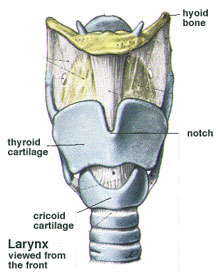LARYNX (VOICE BOX) CANCER

Cancers of the head and neck are treated by the Ear, Nose, and Throat Specialist, also referred to as an Otolaryngologist—Head and Neck Surgeon. Cancers can occur anywhere in the head and neck that is lined with mucous membranes, the moist pink lining inside our noses, mouths, and throats. One such structure is the larynx (voice box). The larynx is the organ in the neck that creates voice. It is also intimately involved in swallowing. Benign (non-cancerous) and malignant (cancerous) growths can occur in and around the larynx.
Many larynx cancers can be treated non-surgically, using either radiation therapy or a combination of chemotherapy and radiation therapy. We always strive to preserve the larynx whenever possible, but there are times when this structure needs to be surgically removed due to the severity of the cancer or perhaps because it has recurred after other forms of therapy. In some cases, the larynx is not functioning properly after other treatment, leading to breathing/swallowing/aspiration problems. In these instances, it is safer to remove the larynx. The name of this procedure is called a total laryngectomy.
Most larynx cancers develop as the result of chronic tobacco and alcohol use, and are called squamous cell carcinomas. There are many signs of larynx cancer, including hoarseness, coughing up blood, throat pain, ear pain, difficulty with or painful swallowing, or shortness of breath. A neck mass might even be the first sign of larynx cancer.
Like all cancers, if you have been diagnosed with larynx cancer, it is important to determine the type and severity (stage) of the cancer. The staging will guide your physician at Suburban Ear, Nose, and Throat as to the most appropriate therapy. The diagnosis of larynx cancer will involve a biopsy (removal of a small piece of the abnormal tissue), which usually requires general anesthesia. At the same time, we will also closely inspect the remainder of the throat (pharynx), trachea (windpipe), and the esophagus, which is involved with swallowing. A close inspection of the entire throat and upper airway is important since there is a 2-3% chance of having a second tumor in one of these areas. Staging often involves a CT scan of the neck and chest, an MRI, or a PET scan. On occasion, special swallowing x-rays will also be obtained.
Once the stage of the tumor is understood, all treatment options will be discussed. As mentioned above, there are three forms of therapy for larynx cancer. Surgery is performed by the Ear, Nose, and Throat Specialist (ENT), radiation therapy is administered under the care of a radiation oncologist, and a medical oncologist provides chemotherapy. Early stage cancers will often only require one of the three forms of therapy, usually either surgery or radiation therapy. For advanced stage cancers, two or often three forms of cancer therapy will be recommended.
The sequence of administration of treatment depends on the specifics of your tumor. For example, sometimes surgery is followed by radiation therapy, or in many cases, chemotherapy and radiation therapy are given at the same time, followed by surgery. Depending on the extent of your tumor, multiple health care providers may be involved in your care. In addition to the above-mentioned specialists, this may include your primary care physician, gastroenterologist, speech pathologist, and others. This is called a "multi-disciplinary" approach to cancer treatment.
If your treatment plan involves surgery, the type of surgery performed by your ENT will vary, depending on the particulars of your tumor. This discussion is about total laryngectomy. Other lesser surgery for larynx cancer is discussed elsewhere in our website. If the tumor in your larynx has spread into the lymph nodes in your neck, a neck dissection (removal of the neck lymph nodes) might be recommended for one or both sides of your neck.
Total laryngectomy will result in a loss of the natural voice, and creation of a permanent breathing hole in the lower neck called a tracheostoma. Several options for voice rehabilitation will be offered. The surgery physically separates the swallowing function from the breathing function and after total laryngectomy, it is expected that patients will be able to tolerate a normal or near normal diet.
The indications and risks of surgery, as well as expected outcomes, must be understood prior to proceeding with your surgery. In addition, you must understand your alternatives to the surgery. Your alternative is not to have the surgery performed, and continue with medical management of your problem.
INTENDED BENEFITS AND EXPECTED OUTCOMES:
- Complete removal of malignant tumor involving the larynx or hypopharynx (bottom of the throat).
- There is a chance of incomplete removal of disease and/or recurrence of the cancer.
- There will be loss of/reduction of smell and taste, as air will not pass thru the nose when breathing.
- There is a chance that tissue from another part of your body will be needed for reconstruction.
RISKS/COMPLICATIONS THAT OCCUR:
Bleeding – heavy bleeding is rare, if this occurs you may need blood transfusion.
Infection – 10‐30% risk.
Pharyngocutaneous fistula – if this occurs you may need additional surgeries to repair, and may prolong your hospitalization.
Tracheal stoma stenosis (narrowing) ‐ causing breathing difficulty and requiring stenting or revision surgery.
Loss of strength to lift heavy weights, an expected outcome.
Pharyngeal (swallowing tube) stenosis (narrowing) causing dysphagia (swallowing problems).
Hypothyroidism ‐ low thyroid function would need daily pill to replace.
Hypoparathyroidism – low blood calcium would need multiple medications taken daily.
RARE RISKS/COMPLICATIONS WITH SERIUS CONSEQUENCES:
Pneumothorax – collapse of lung, would then need further intervention.
Skin necrosis – wound problems, may need further surgery to help heal.
Nerve injury – hypoglossal nerve controlling tongue function.
Death due to serious surgical and/or anesthetic complications.
AFTER THE PROCEDURE:
You will breathe through an opening in the neck, which is connected to the trachea.
You can expect a 1‐2 week hospitalization after surgery; sometimes patients then require short-term stay in a rehabilitation facility.
Sometimes the surgery is combined with other surgeries, such as neck dissection, creation of opening in the throat for voice rehabilitation, etc.
You cannot eat by mouth for 1 to 3 weeks. Tube feeding will provide nourishment.
As healing progresses vocal rehabilitation will be undertaken.
ALTERNATIVES TO TOTAL LARYNGECTOMY:
Radiation therapy.
Chemotherapy.
Symptomatic palliative treatment (non‐curative treatment/comfort measures)
No treatment: consequences of not treatment are progression of tumor and death.
As your healthcare provider, we at Suburban Ear, Nose, and Throat take great pride in helping you understand each step along the path of your individual cancer treatment. If you are diagnosed with larynx cancer, we will develop a lifetime relationship of close follow-up and support. We go to great lengths to try to help you understand your plan of care. If at any time during your care you have questions or concerns, please call us at 847‐259‐2530.
